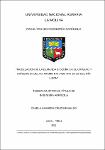Mostrar el registro sencillo del ítem
Modelación de la demanda bioquímica de oxígeno y oxígeno disuelto, tramo km 0+000 -km 20+130 del río Lurín
| dc.contributor.advisor | Ramos Fernández, Lía | |
| dc.contributor.author | Cruz Grimaldo, Camila Leandra | |
| dc.date.accessioned | 2021-09-22T14:10:05Z | |
| dc.date.available | 2021-09-22T14:10:05Z | |
| dc.date.issued | 2021 | |
| dc.identifier.uri | https://hdl.handle.net/20.500.12996/4932 | |
| dc.description | Universidad Nacional Agraria La Molina. Facultad de Ingeniería Agrícola. Departamento Académico de Recursos Hídricos | es_PE |
| dc.description.abstract | El río Lurín, ubicado al sur de Lima, presenta altos índices de contaminación, esto debido al aumento de la demanda del agua producto del incremento poblacional, vertimientos de aguas residuales (tratadas y sin tratar) e inadecuado manejo del recurso. Por ello, el presente trabajo de investigación tiene como finalidad la modelación del oxígeno disuelto y la demanda bioquímica de oxígeno, mediante el modelo matemático Streeter-Phelps, para lo cual se realizó la recolección de información en 13 puntos de monitoreo de la parte baja del río durante el periodo de febrero a agosto del 2019, tales como: OD, DBO, velocidad del flujo de agua, tirante del agua y ancho geométrico del río. Además, se elaboró el modelo digital de elevación mediante imágenes obtenidas de un vehículo aéreo no tripulado-VANT, así como de topografía e imágenes satelitales de la zona de estudio, con esta información se obtuvieron las características hidráulicas del río mediante el programa HEC-RAS, y calibrándose el modelo Streeter- Phelps con un algoritmo de optimización (Excel-Solver), en el que fue más evidente en periodo de estiaje, la presencia de contaminación difusa en los distritos de Pachacamac y filtraciones por recarga del acuífero al río. En el modelo se determinó los parámetros de k1, k2 y k3 con valores máximos de: 4,51 d-1, 55,05 d-1 y 13,43 d-1 respectivamente en las secciones del río, lo cual permitió predecir el comportamiento del OD y la DBO, y simular escenarios con alternativas de mejora para la calidad del recurso hídrico, siendo la optimización de la PTAR San Bartolo y la implementación de una PTAR en el distrito de Pachacamac la alternativa con mayor viabilidad para que el río cumpla con los estándares de calidad del agua. | es_PE |
| dc.description.abstract | The Lurín river, located in Lima, presents high levels of contamination, due to the increase in water demand as a result of the population increase, inadequate handling of solid waste, and discharges of wastewater (treated and untreated). Therefore, the present research work aims to model water quality using the Streeter-Phelps mathematical model, for which the collection of information on: dissolved oxygen, biochemical oxygen demand, temperature, speed, tension was carried out. and river width in 13 monitoring points of the lower part of the river, in addition, the digital elevation model was elaborated using images obtained from an unmanned aerial vehicle, topography and satellite images of the study area. With this information, the hydraulic characteristics of the river were obtained through the HEC-RAS program, with which the modeling of dissolved oxygen, biochemical oxygen demand was carried out, as well as the deoxygenation, re-aeration and sedimentation parameters of the sections of the river. river, in the Excel program with its Solver add-in, which made it possible to predict the behavior of DO and BOD to later carry out the simulation of scenarios with alternatives for improvement for the quality of the water resource, among which is the optimization of Wastewater Treatment Plant San Bartolo treatment and the implementation of a WWTP in Pachacamac district so that the river meets the water quality standards because the studies carried out reliably show that the river does not comply with current regulations, for which it is expected that with the scenarios proposed it is possible to recover the quality of the water in the lower part of the Lurín river. | en_US |
| dc.format | application/pdf | en_US |
| dc.language.iso | spa | es_PE |
| dc.publisher | Universidad Nacional Agraria La Molina | es_PE |
| dc.rights | info:eu-repo/semantics/embargoedAccess | en_US |
| dc.rights.uri | https://creativecommons.org/licenses/by-nc-nd/4.0/ | * |
| dc.subject | Cuencas hidrográficas | es_PE |
| dc.subject | Oxígeno | es_PE |
| dc.subject | Demanda | es_PE |
| dc.subject | Geomorfología | es_PE |
| dc.subject | Cursos de agua | es_PE |
| dc.subject | Modelos | es_PE |
| dc.subject | Técnicas de predicción | es_PE |
| dc.subject | Aplicaciones del ordenador | es_PE |
| dc.subject | Métodos estadísticos | es_PE |
| dc.subject | Perú | es_PE |
| dc.subject | Modelación | es_PE |
| dc.subject | Río Lurín | es_PE |
| dc.title | Modelación de la demanda bioquímica de oxígeno y oxígeno disuelto, tramo km 0+000 -km 20+130 del río Lurín | es_PE |
| dc.type | info:eu-repo/semantics/bachelorThesis | en_US |
| thesis.degree.discipline | Ingeniería Agrícola | es_PE |
| thesis.degree.grantor | Universidad Nacional Agraria La Molina. Facultad de Ingeniería Agrícola | es_PE |
| thesis.degree.name | Ingeniero Agrícola | es_PE |
| dc.subject.ocde | https://purl.org/pe-repo/ocde/ford#1.05.11 | es_PE |
| renati.author.dni | 47989273 | es_PE |
| dc.publisher.country | PE | es_PE |
| dc.type.version | info:eu-repo/semantics/publishedVersion | en_US |
| dc.date.embargoEnd | 2023-08-20 | |
| dc.date.embargoEnd | 2023-08-20 | |
| renati.advisor.orcid | https://orcid.org/0000-0003-3946-7188 | es_PE |
| renati.advisor.dni | 07462206 | es_PE |
| renati.type | https://purl.org/pe-repo/renati/type#tesis | es_PE |
| renati.level | https://purl.org/pe-repo/renati/level#tituloProfesional | es_PE |
| renati.discipline | 811096 | es_PE |
| renati.juror | Chávarri Velarde, Eduardo Abraham | |
| renati.juror | Miglio Toledo de Rodriguez, Rosa María | |
| renati.juror | Arapa Quispe, José Bernardino |
Ficheros en el ítem
Este ítem aparece en la(s) siguiente(s) colección(ones)
-
IAG-RH Tesis [310]



